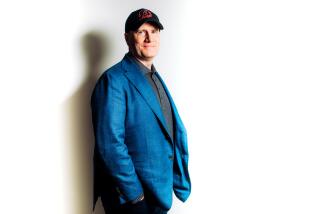Review: Stan Lee: Genius or huckster? A new biography of the Marvel creator weighs in
On the Shelf
True Believer: The Rise and Fall of Stan Lee
By Abraham Riesman
Crown: 416 pages, $28
If you buy books linked on our site, The Times may earn a commission from Bookshop.org, whose fees support independent bookstores.
Shortly after Stan Lee, the Marvel Comics legend, died in 2018 at 95, biographer Abraham Riesman paid a visit to his only sibling, younger brother Larry Lieber. Though he had drawn comics for Stan on and off for 60 years, Lieber never felt emotionally close to him. He tried to explain his brother the best way he knew how: by comparing him to an iconic film character. “I feel like I’m talking about Charles Foster Kane,” he told Riesman. “Who was he? What was he? What was he like? It depends on who you talk to at what moment.”
Riesman, whose 2016 article dissecting the Lee Myth went viral, has now written a book-length biography to peel back all the layers on his complex subject. “True Believer: The Rise and Fall of Stan Lee” is a well-researched, engrossing and compulsively readable book. It’s also brutal.
The Lee of Riesman’s book is not just a teller of tall tales, a genial old huckster, an ambitious and shrewd promoter of both self and medium — although he is certainly all those things. He is also a serial abuser of the truth, a hack whose creative pursuits mostly flop, a failed businessman lusting after a buck and a dysfunctional family man. There’s a corrective to be offered to the Lee Myth, but Riesman overplays his hand, diminishing his biography’s strengths by shading every story to Lee’s disadvantage.
The most illuminating sections focus on Lee’s personal life. Its raw material is straight out of Dickens by way of Kitty Kelley. Start with Stan’s dad, Jack Lieber, who quarreled constantly with his sons about how they brushed their teeth, sat in a chair or conducted themselves in public. The Liebers (Stan adopted Lee as a pen name in 1941) hovered on the edge of poverty, and we learn that Stan always viewed his father as a professional “loser.” The ill feeling ran both ways; Jack didn’t think much of Stan’s career, and he really disapproved of Stan’s marriage to Joan Boocock, a non-Jew. Even more upsetting to Jack, Stan and Joan had their only daughter, Joan Celia (“JC”), baptized after her birth in 1950.
Riesman’s portrait of the two Lee women is biting. Joan comes across as a dilettante, whiling away her days drinking with friends and spending Stan’s money. “Joan drank these martinis and she was very much like, ‘Ahh dahhling,’” recalled one friend, “eating and drinking and partying, telling jokes, laughing, ranting about politics.” JC, meanwhile, appears as a spoiled child drifting from pursuit to pursuit, never holding down a real job and counting on her father to foot the bill for houses and cars well into her 60s.
Jon Meacham’s “His Truth Is Marching On: John Lewis and the Power of Hope” honors Lewis’ resistance but leaves out the hard work that got us here.
On the central question of Lee’s role in the creation of the Marvel Universe, Riesman doesn’t shed any new light. He views the paper trail as too thin and the participants’ memories as too inconsistent to draw definitive conclusions. Lee himself offered at least four different versions of how he came up with the Fantastic Four. Only on the origin of Spider-Man does Riesman come down convincingly in favor of Steve Ditko as the primary creator. But he then takes a potshot at Lee’s most important contribution — Spider-Man’s motto “With great power there must also come great responsibility” — by suggesting Lee cribbed it from Churchill or FDR. Perhaps. But no one had used it as a pithy slogan or a superhero’s personal creed before.
Riesman comes at the creation debate sideways — seeding doubt by emphasizing Lee’s unreliability as a narrator, his lack of other creative success and his wavering commitment to comics. And of course Lee did contradict himself at every turn. None of his famous stories were true, really: not the one about winning the newspaper contest as a kid; not the one about his hiring at Marvel forerunner Timely Comics; not the one about Federico Fellini visiting Marvel’s office in 1965.
The biographer makes sure readers also know that Lee was no super fan when it came to comics. Among the many bits of evidence is a 1969 conversation Lee had with a friend, French director Alain Resnais, immortalized on a home movie reel: “I can’t understand people who read comics. I wouldn’t read them if I had the time and wasn’t in the business.”
But all this myth-busting leaves a crucial question unanswered: What accounts for Marvel’s amazing burst of creativity in the ’60s? Riesman nods to Lee’s skill for zippy dialogue. He gives him credit for inventing the concept of a shared Marvel Universe, as Spider-Man’s arc crossed over into the world of the Fantastic Four and the Avengers. But he doesn’t explore Lee’s contribution in detail.
So who is the real Lee? The great promoter of the medium, who broke the fourth wall between creator and fan, and who inspired today’s fan culture? Or the shiftless hack who hated his profession?
In focusing on the feuds with Jack Kirby and Ditko, “True Believer” downplays others who liked working with Lee. Many appreciated the Marvel method, in which the writer handed off an outline for the artist to draw before adding the dialogue. They also liked the freedom Lee gave writers and artists and the stable of complex characters.
Wanda and Vision are living in a sitcom world in ‘WandaVision.’ We dig into the Marvel comics that might help you make sense of the Disney+ show.
The second generation of creators who followed Kirby and Ditko — Roy Thomas, John Romita Sr., Chris Claremont, Neal Adams — all had much better relationships with Lee. “He was equally good as an editor, equally good as a manager,” Claremont fondly recalled to Riesman. “He was the sun around which we all orbited.”
The book shines when detailing Lee’s professional life after his 1980 move to Los Angeles, where he struggled to be taken seriously in Hollywood. Many in the movie business were comic fans, clamoring to socialize with Lee but not to do real business with him. “Stan had this sadness,” recalled screenwriter Ron Friedman, a friend during those years, “and the sadness was, ‘The people I hope to reach don’t value what I’ve done.’”
Pitches for Marvel movies went nowhere. Lee was laughed out of a studio office when he pitched an American version of a then-unknown Japanese TV show, only to see Haim Saban turn it into “Mighty Morphin Power Rangers.” Riesman really drives home how much the later success of the Marvel Cinematic Universe retroactively enhanced Lee’s reputation.
In recounting the scandalous last few years of Lee’s life, Riesman flashes the virtues and flaws of a skilled magazine writer capturing moments in their vivid immediacy. But he sometimes lacks the historical perspective of a biographer. Many of these later-life details feel disproportionate to the totality of Lee’s life and his place in the messy pantheon of Cold War American popular culture.
A year or so after Lee’s death, Disney staged a massive, televised tribute to Lee in New York City heavy with clips and stars from the Marvel movies. Larry Lieber, Stan’s 87-year-old kid brother, living alone in a cramped Manhattan studio apartment, wasn’t invited. His absence amidst the high-wattage salute recalled something he said to Riesman about his celebrated brother just after Stan’s death. “What’s the famous line from — you probably know it — ‘The Man Who Shot Liberty Valance’? When the legend becomes fact, print the legend.”
With the ‘X-Men’ Debut and a New Internet Animation Company, the 77-Year-Old Comics Icon Is Exploring Bold New Frontiers. Is Lee the Real Thing, or the Incredible Huckster?
Lewis is the author of “The Shadows of Youth: The Remarkable Journey of the Civil Rights Generation,” among other books.
More to Read
Sign up for our Book Club newsletter
Get the latest news, events and more from the Los Angeles Times Book Club, and help us get L.A. reading and talking.
You may occasionally receive promotional content from the Los Angeles Times.






